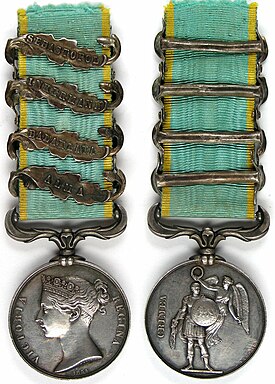Crimea Medal

Multi tool use
| Crimea Medal | |
|---|---|
 Obverse and reverse of the medal. | |
| Awarded by | |
| Type | Campaign medal |
| Eligibility | British forces. |
| Awarded for | Campaign service. |
| Campaign(s) | Crimean War. |
| Description | Silver disk, 36mm diameter. |
| Clasps |
|
| Statistics | |
| Established | 15 December 1854 |
| Total awarded | 275,000[1] |
| Related | Turkish Crimea Medal Baltic Medal |

Crimea Medal with unofficial French bar 'Traktir'
The Crimea Medal was a campaign medal approved on 15 December 1854, for issue to officers and men of British units (land and naval) which fought in the Crimean War of 1854–56 against Russia. The medal was awarded with the British version of the Turkish Crimea Medal, but when a consignment of these were lost at sea, some troops were issued with the Sardinian version instead.[2] The Crimea medal was also presented to certain members of allied French forces.[1]
The troops who landed in the Crimea after 9 September 1855, the day Sebastopol fell, did not receive the medal unless they had been engaged against the enemy after that date.[3]

Cartoon from Punch magazine titled Patient Heroes. The caption reads:
Well Jack! Here's good news from home. We are going to have a medal.
That’s very kind. Maybe one of these days we'll have a coat to stick it on!In December 1854, when the medal was sanctioned, there was widespread criticism in Britain that the troops were not receiving winter supplies, including warm clothing.[4]
Contents
1 Design
2 Clasps
3 See also
4 Notes
5 Bibliography
6 External links
Design
The medal consists of a 36mm silver disk with, on the obverse, the diademed head of Queen Victoria and the legend VICTORIA REGINA with the date 1854 below. The reverse has a depiction of a standing Roman warrior about to receive a laurel crown from a flying figure of victory, the word CRIMEA appearing on the left.
The medal is notable for its unusually ornate clasps. Each is in the form of an oak leaf with an acorn at each end, a style not used on any other British medal. The ornate, floriated, swivelling suspender is also unique to the Crimea Medal.[2]
The 27 millimetres (1.1 in) wide ribbon[1] is pale blue with yellow edges.
Clasps
Five clasps were authorised:[1]
Alma. For the battle of 20 September 1854.
Balaklava. For the battle of 25 October 1854.
Inkerman. For the battle of 5 November 1854.
Sebastopol. For the siege that lasted from 11 September 1854 to 9 September 1855.
Anyone who received the Balaklava or Inkerman clasps was also awarded this bar.[5]
Azoff. For the Naval expedition in the Sea of Azoff from 25 May to 22 September 1855. It was awarded only to Royal Navy personnel.
The Alma and Inkerman clasps were authorised in December 1854 at the same time as the medal, with that for Balaklava on 23 February 1855, Sebastopol on 13 October 1855[1] and Azoff on 2 May 1856.[6] No person received more than four clasps.
The medal was issued to a limited number of allied French forces,[7]
unofficial French bars being sometimes added, including Traktir, Tchernaia, Mer d'Azoff, and Malakof, in addition to the British clasps.[1]
See also
- Category:Recipients of the Crimea Medal
- Baltic Medal
- Turkish Crimean War medal
- Turkish Order of the Medjidie
- Sardinian Crimea Medal
- Légion d'honneur
- Médaille militaire
- Crimean War medal (disambiguation)
Notes
^ abcdef Joslin, Litherland, and Simpkin 1988, p. 128.
^ ab Christodoulou , Glenn, Medals of the Crimean War - Crimean War Research Society (1985)
^ Medals and Their History, W. A. Steward 1915, page 152
^ Martin, Theodore (1877). The Life of His Royal Highness the Prince Consort, Volume III, page 181. Smith Elder & Co, London..mw-parser-output cite.citation{font-style:inherit}.mw-parser-output .citation q{quotes:"""""""'""'"}.mw-parser-output .citation .cs1-lock-free a{background:url("//upload.wikimedia.org/wikipedia/commons/thumb/6/65/Lock-green.svg/9px-Lock-green.svg.png")no-repeat;background-position:right .1em center}.mw-parser-output .citation .cs1-lock-limited a,.mw-parser-output .citation .cs1-lock-registration a{background:url("//upload.wikimedia.org/wikipedia/commons/thumb/d/d6/Lock-gray-alt-2.svg/9px-Lock-gray-alt-2.svg.png")no-repeat;background-position:right .1em center}.mw-parser-output .citation .cs1-lock-subscription a{background:url("//upload.wikimedia.org/wikipedia/commons/thumb/a/aa/Lock-red-alt-2.svg/9px-Lock-red-alt-2.svg.png")no-repeat;background-position:right .1em center}.mw-parser-output .cs1-subscription,.mw-parser-output .cs1-registration{color:#555}.mw-parser-output .cs1-subscription span,.mw-parser-output .cs1-registration span{border-bottom:1px dotted;cursor:help}.mw-parser-output .cs1-ws-icon a{background:url("//upload.wikimedia.org/wikipedia/commons/thumb/4/4c/Wikisource-logo.svg/12px-Wikisource-logo.svg.png")no-repeat;background-position:right .1em center}.mw-parser-output code.cs1-code{color:inherit;background:inherit;border:inherit;padding:inherit}.mw-parser-output .cs1-hidden-error{display:none;font-size:100%}.mw-parser-output .cs1-visible-error{font-size:100%}.mw-parser-output .cs1-maint{display:none;color:#33aa33;margin-left:0.3em}.mw-parser-output .cs1-subscription,.mw-parser-output .cs1-registration,.mw-parser-output .cs1-format{font-size:95%}.mw-parser-output .cs1-kern-left,.mw-parser-output .cs1-kern-wl-left{padding-left:0.2em}.mw-parser-output .cs1-kern-right,.mw-parser-output .cs1-kern-wl-right{padding-right:0.2em}
^ The Crimean War Medal
^ "London Gazette 2 May 1856, page 1629". Retrieved 16 September 2017.
^ Ribbons and Medals by Captain H. Taprell Dorling, page 64
Bibliography
- Mackay, J and Mussel, J (eds) - Medals Yearbook - 2006, (2005), Token Publishing.
- Joslin, Litherland, and Simpkin (eds) - British Battles and Medals, (1988), Spink.
- Steward, William Augustus - Medals and Their History, (1915), Stanley Paul & Co, London.
- Taprell Dorling, Captain H. - Ribbons and Medals, (1956), A.H.Baldwin & Sons, London.
External links
The Crimean War Medal by Mike Hargreave Mawson- Illustrated Identification Guide to Crimean War Medals
"The King's Own Royal Regiment Museum, (Lancaster), Crimea Medal". www.kingsownmuseum.plus.com.
8e9r4bDqG0eeN1R3MhfWpAi1WMzH8h8e5tlmnX,3ZevU,V0XUQAt,g5q,rREIFz,CjRFAvO